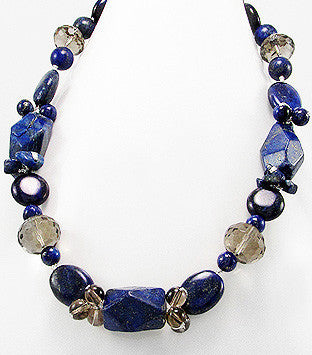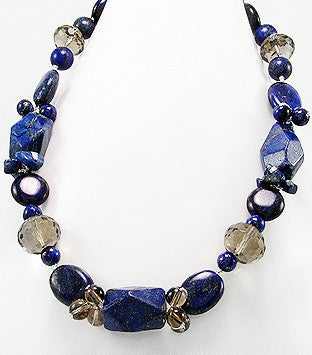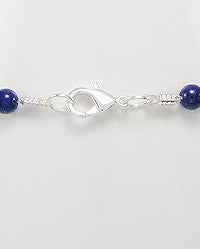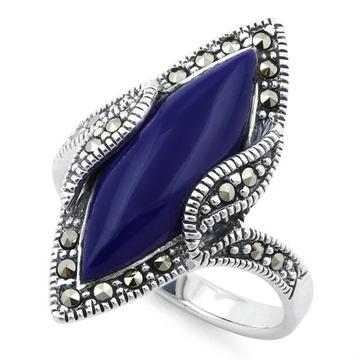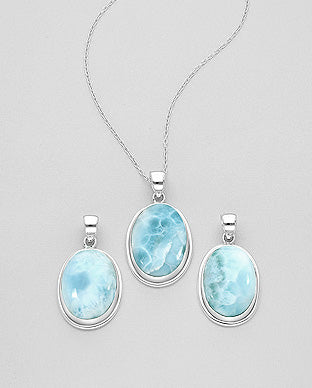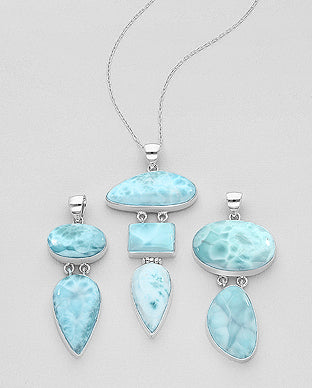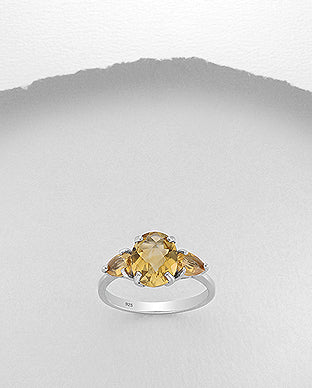Lapis Lazuli Necklace
Prized since antiquity for its intense color, Lapis Lazuli with Smoky Quartz accents in a beaded and wrapped Japanese silk cord necklace for a wearable art piece. Necklace makes a perfect casual addition to your favorite clothing in an easy to wear, bead width maximum 0.47", 17" length, lobster clasp and pure silver plating. Add the earrings, bracelet and ring for a complete ensemble.
Shipping:
Free shipping within U.S. Outside U.S. buy 2 jewelry items get free shipping.
What is Lapis Lazuli...
Lapis lazuli (sometimes abbreviated to lapis) is a deep blue semi-precious stone that has been prized since antiquity for its intense color.
In the Ancient World
Lapis lazuli has been mined in Afghanistan and exported to the Mediterranean world and South Asia since the Neolithic age. Lapis lazuli beads have been found at Mehrgarh, a neolithic site near Quetta in Pakistan, on the ancient trade route between Afghanistan and the Indus Valley, dating to the 7th millennium. Quantities of these beads have also been found at 4th millennium BC settlements in Northern Mesopotamia, and at the Bronze Age site of Shahr-e Sukhteh in southeast Iran (3rd millennium BC). A dagger handle with a lapis handle, a bowl inlaid with lapis, and amulets, beads, and inlays representing eyebrows and beards, were found in the Royal Tombs of the Sumerian city-state of Ur from the 3rd Millennium BC.
Lapis was also used in ancient Mesopotamia by the Akkadians, Assyrians, and Babylonians for seals and jewelry. In the Mesopotamian poem, the Epic of Gilgamesh (17th-18th Century BC); one of the oldest known works of literature, lapis lazuli is mentioned several times. The Statue of Ebih-Il, a 3rd millennium BC statue found in the ancient city-state of Mari in modern-day Syria, now in the Louvre, uses lapis lazuli inlays for the irises of the eyes.
Lapis lazuli also made its way across the Mediterranean to ancient Egypt, where it was a favorite stone for amulets and ornaments such as scarabs; Lapis jewelry has been found at excavations of the Predynastic Egyptian site Naqada (3300–3100 BC). At Karnak, the relief carvings of Thutmose III (1479-1429 BC) show fragments and barrel-shaped pieces of lapis lazuli being delivered to him as tribute. Powdered lapis was used as eyeshadow by Cleopatra.
In late classical times and as late as the Middle Ages, lapis lazuli was often called sapphire (sapphirus in Latin, sappir in Hebrew), though it had little to do with the stone today known as the blue corundum variety sapphire. In his book on stones, the Greek scientist Theophrastus described "the sapphirus, which is speckled with gold," a description which matches lapis lazuli.
There are many references to sapphires in the Old Testament, but most scholars agree that, since sapphires were not known before the Roman Empire, they most likely are references to lapis lazuli. For instance, Exodus 24:10: "As they saw the God of Israel, and there was under his feet as it were a paved work of a sapphire stone.." (KJV). The term used in the Latin Vulgate Bible in this citation is "lapidus sapphiri," the term for lapis lazuli. In modern translations of the Bible, such as the New Living Translation Second Edition, references a surface like brilliant bluelapis lazuli as clear as the sky as being under God's feet.






